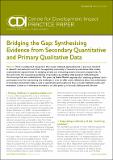| dc.contributor.author | Roelen, Keetie | |
| dc.coverage.spatial | Burundi | en |
| dc.coverage.spatial | Ethiopia | en |
| dc.coverage.spatial | Vietnam | en |
| dc.date.accessioned | 2016-02-26T12:32:14Z | |
| dc.date.available | 2016-02-26T12:32:14Z | |
| dc.date.issued | 2016-02 | |
| dc.identifier.citation | Roelen, K. (2016) Bridging the Gap: Synthesising Evidence from Secondary Quantitative and Primary Qualitative Data, CDI Practice Paper 15, Brighton: IDS | en |
| dc.identifier.uri | https://opendocs.ids.ac.uk/opendocs/handle/20.500.12413/9579 | |
| dc.description.abstract | There is widespread recognition that mixed-methods approaches are a ‘platinum standard’
in research and evaluation and that the expanding availability of secondary quantitative data creates unprecedented opportunities for studying poverty and evaluating poverty reduction programmes. At the same time, this expanding availability of secondary quantitative data presents methodological shortcomings that are underexplored. This paper by Keetie Roelen explores the ‘matching problem’ and a participatory tool for overcoming this challenge in a bid to offer wider reflections about the combination of secondary and primary data as well as quantitative and qualitative data in mixed-methods studies and evaluation. It does so in reference to research on child poverty in Burundi, Ethiopia and Vietnam. | en |
| dc.description.sponsorship | UK Department for International Development | en |
| dc.language.iso | en | en |
| dc.publisher | IDS | en |
| dc.relation.ispartofseries | CDI Practice Paper;15 | |
| dc.rights.uri | http://creativecommons.org/licenses/by/3.0/ | en |
| dc.subject | Children and Youth | en |
| dc.subject | Poverty | en |
| dc.title | Bridging the Gap: Synthesising Evidence from Secondary Quantitative and Primary Qualitative Data | en |
| dc.type | CDI Practice Paper | en |
| dc.rights.holder | IDS | en |
| dc.identifier.ag | OT/11009/7/3/1/327 | |


